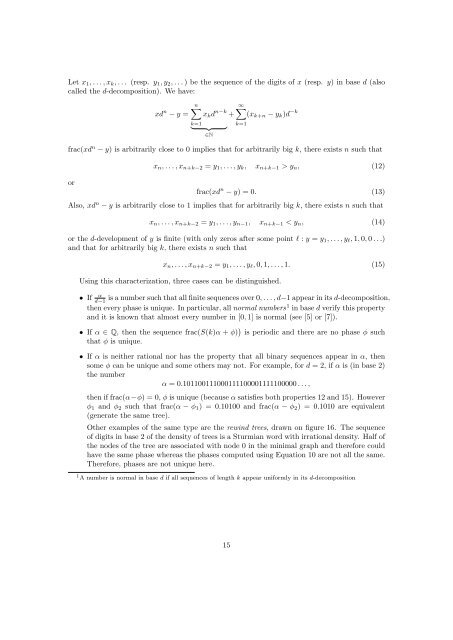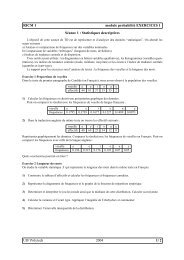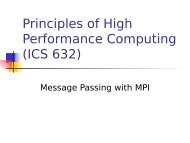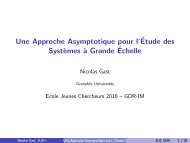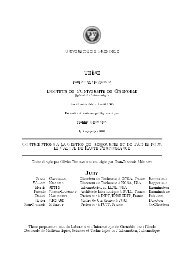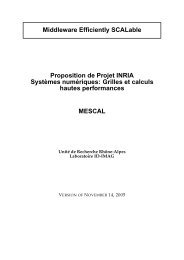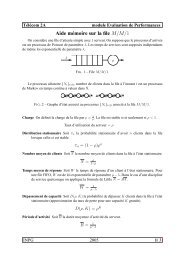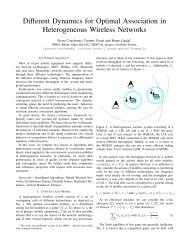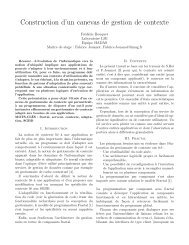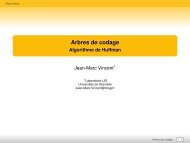Distributing labels on infinite trees
Distributing labels on infinite trees
Distributing labels on infinite trees
Create successful ePaper yourself
Turn your PDF publications into a flip-book with our unique Google optimized e-Paper software.
Let x 1 , . . . , x k , . . . (resp. y 1 , y 2 , . . . ) be the sequence of the digits of x (resp. y) in base d (alsocalled the d-decompositi<strong>on</strong>). We have:xd n − y =n∑∞∑x k d n−k + (x k+n − y k )d −kk=1} {{ }∈Nfrac(xd n − y) is arbitrarily close to 0 implies that for arbitrarily big k, there exists n such thatork=1x n , . . . , x n+k−2 = y 1 , . . . , y k , x n+k−1 > y n , (12)frac(xd n − y) = 0. (13)Also, xd n − y is arbitrarily close to 1 implies that for arbitrarily big k, there exists n such thatx n , . . . , x n+k−2 = y 1 , . . . , y n−1 , x n+k−1 < y n , (14)or the d-development of y is finite (with <strong>on</strong>ly zeros after some point l : y = y 1 , . . . , y l , 1, 0, 0 . . .)and that for arbitrarily big k, there exists n such thatx n , . . . , x n+k−2 = y 1 , . . . , y l , 0, 1, . . . , 1. (15)Using this characterizati<strong>on</strong>, three cases can be distinguished.α• Ifd−1is a number such that all finite sequences over 0, . . . , d−1 appear in its d-decompositi<strong>on</strong>,then every phase is unique. In particular, all normal numbers 1 in base d verify this propertyand it is known that almost every number in [0, 1] is normal (see [5] or [7]).• If α ∈ Q, then the sequence frac(S(k)α + φ) ) is periodic and there are no phase φ suchthat φ is unique.• If α is neither rati<strong>on</strong>al nor has the property that all binary sequences appear in α, thensome φ can be unique and some others may not. For example, for d = 2, if α is (in base 2)the numberα = 0.101100111000111100001111100000 . . . ,then if frac(α−φ) = 0, φ is unique (because α satisfies both properties 12 and 15). Howeverφ 1 and φ 2 such that frac(α − φ 1 ) = 0.10100 and frac(α − φ 2 ) = 0.1010 are equivalent(generate the same tree).Other examples of the same type are the rewind <strong>trees</strong>, drawn <strong>on</strong> figure 16. The sequenceof digits in base 2 of the density of <strong>trees</strong> is a Sturmian word with irrati<strong>on</strong>al density. Half ofthe nodes of the tree are associated with node 0 in the minimal graph and therefore couldhave the same phase whereas the phases computed using Equati<strong>on</strong> 10 are not all the same.Therefore, phases are not unique here.1 A number is normal in base d if all sequences of length k appear uniformly in its d-decompositi<strong>on</strong>15


